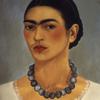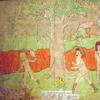Illuminating Women in the Medieval World at the J. Paul Getty Museum
- LOS ANGELES, California
- /
- June 12, 2017
Modern portrayals of medieval women tend toward stereotypical images of damsels in distress, mystics in convents, female laborers in the fields, and even women of ill repute. In fact, women’s roles in the Middle Ages were varied and nuanced, and medieval depictions of womanhood were multi-faceted. Illuminating Women in the Medieval World, on view June 20 –September 17, 2017 at the J. Paul Getty Museum at the Getty Center, reveals the vibrant and complex medieval representations of women, real and imagined, who fill the texts and images within illuminated manuscripts.
“The roles of women in medieval times is a subject that has been little explored despite the considerable visual and literary evidence that exists,” explains Timothy Potts, director of the J. Paul Getty Museum. “There are abundant representations of women in medieval art with which we are all familiar, including female saints, royals, and everyday laborers. Looking beyond this core, Illuminating Women highlights the more varied roles that women actually played in the Middle Ages, including those that are less known, such as that of arts patron. The extraordinary depth and quality of the Getty’s manuscripts collection allow us to explore this fascinating subject in all of its richness and complexity.”
Ranging from the Virgin Mary to the adulterous Bathsheba, the exhibition is divided into five sections and features a wide variety of female figures and roles. Section one focuses on the biblical heroines, female saints, and pious nuns who were held in high regard as models of proper behavior. The second section discusses their counterpoint: lascivious women, who were used as warnings against sinful conduct. The third section examines women in their relationships with men, other women, and children. The fourth considers women in the medieval arts, and their relationship with commissioning and creating manuscripts. The exhibition ends with works by modern-day female artists who drew upon medieval imagery and artistic techniques.
Medieval Ideals of Womanhood
Medieval notions of ideal womanhood highlighted a range of traditionally pious and subservient roles. For Christians, the Virgin Mary was the ultimate female archetype. Her obedience to God, conception of Jesus without sin, and love for her son from his childhood through death on the cross set a paradigm for the faithful. Early Christian female martyrs who were brutally tortured for refusing to worship pagan gods or to marry outside their faith offered other historical models of piety. Similarly, women saints from the recent medieval past provided contemporary examples for women, and men, to follow.
Warnings to Medieval Women
In addition to establishing positive role models, medieval artists and thinkers used the Judeo-Christian account of creation to reinforce negative conceptions about women. In these traditions, Adam and Eve were tempted to partake of the forbidden fruit of the Tree of Knowledge, giving rise to original sin. In the Middle Ages, authors and theologians largely blamed Eve for this indiscretion; as a result, women were thought by many to be weak in character, temptresses unable to select the best course of action, and in need of guidance. Sometimes virtuous and wanton women were juxtaposed in the same image to emphasize the distinction between good and bad deeds. Overall, more virtuous models were presented in the pages of manuscripts than wanton warnings, but both types of iconography compelled the medieval reader to consider his or her own behavior.
Medieval Women in Daily Life
The consistent presence of women in illuminated manuscripts attests to their active participation in most aspects of medieval life, even though few of their words survive. Many women’s lives followed a path from courtship and marriage, to childbearing and child-rearing. In the ruling classes, wives also performed an important political role as negotiators, and they cemented political and economic relationships by marrying. Women of the lower and middle classes harvested crops, raised livestock, and made and sold crafts; upper-class women drove the market for luxury goods. Other women took religious vows, and it was in convents that female literacy was first taught and encouraged, eventually spreading to royalty, the nobility, and the middle class.
Medieval Women in the Arts
Books of hours were the medieval bestsellers of their day and the most common type of manuscript owned by women. They were considered appropriate possessions for wealthy Christian women and proof of individual piety. Many female owners chose to have their portraits painted into these heavily illuminated books; they usually appear kneeling in prayer before the Virgin or a patron saint. According to Christine Sciacca, curator of the exhibition, “Female patrons of medieval manuscripts often determined how they wanted to be portrayed in their illuminated books. These images of women therefore offer rare insights into everything from their monetary wealth and devotional interests, to their hopes and desires in life and in death.”
Although very few female artists from the Middle Ages are known to us by name, some records survive of their work, including Jeanne de Montbaston, a Parisian bookseller and illuminator who, with her husband, ran a successful workshop. Responsible for several illuminations in a copy of the Romance of the Good Knight Tristan (about 1320-40), she swore a professional oath to the university in Paris after her husband’s death in order to continue working as an illuminator and bookseller in the city.
A Modern Epilogue
The nineteenth and early twentieth centuries saw a renewed interest in the study and revival of medieval art and architecture in both Europe and America. The final section features two works from this period by female artists who have continued the traditions and techniques of manuscript illumination or revisited subject matter typically found in medieval manuscripts, demonstrating an enduring fascination with the medieval expression of womanhood in its many facets.
Illuminating Women in the Medieval World will be on view June 20 through September 17, 2017 at the J. Paul Getty Museum. The exhibition is curated by Christine Sciacca, former assistant curator of Manuscripts at the J. Paul Getty Museum, now Associate Curator of European Art, 300-1400 CE at The Walters Art Museum. A richly illustrated book, Illuminating Women in the Medieval World, will be published by Getty Publications to complement the exhibition.
Additional information is available at www.getty.edu.

270x400_c.jpg)









100x100_c.jpg)


![Peter Paul Rubens (Flemish, 1577–1640), After Titian (Tiziano Vecelli) (Italian [Venetian], c. 1488–1576), Rape of Europa, 1628–29. Oil on canvas, 71 7/8 x 79 3/8 in. Peter Paul Rubens (Flemish, 1577–1640), After Titian (Tiziano Vecelli) (Italian [Venetian], c. 1488–1576), Rape of Europa, 1628–29. Oil on canvas, 71 7/8 x 79 3/8 in.](/images/c/e2/2e/Jan20_Rape_of_Europa100x100_c.jpg)





